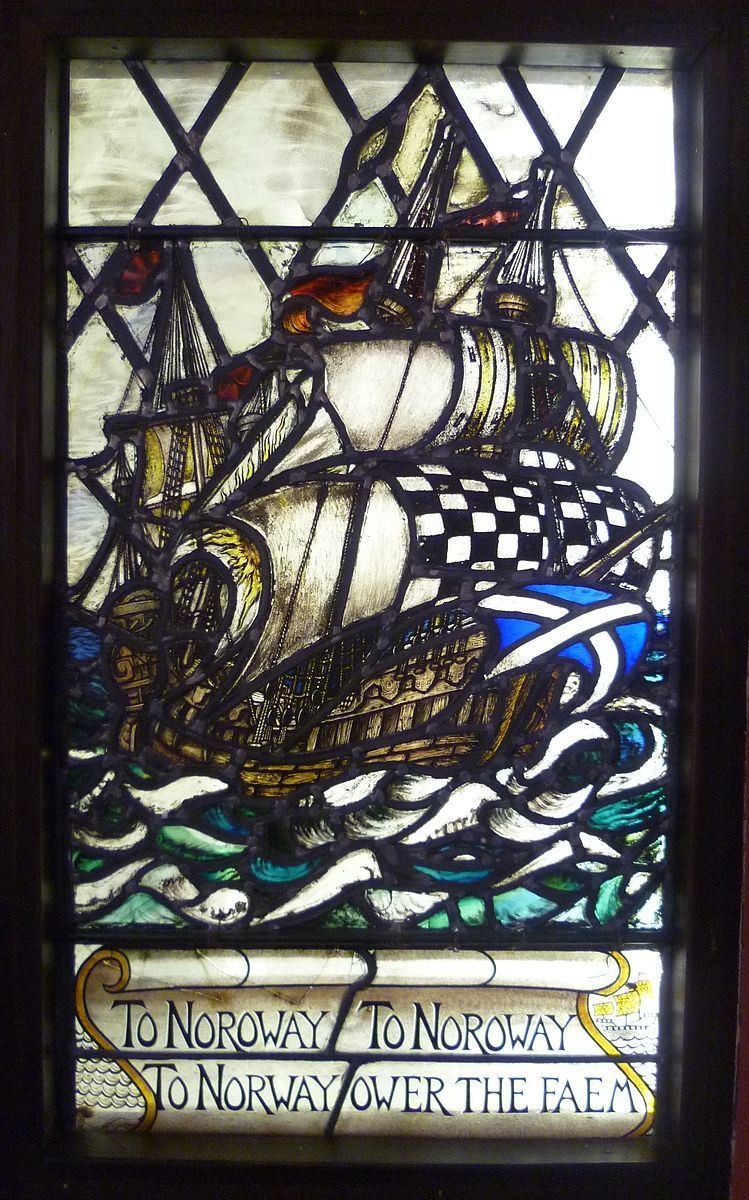 | ||
"Sir Patrick Spens" is one of the most popular of the Child Ballads (No. 58) (Roud 41), and is of Scottish origin. It is a maritime ballad about a disaster at sea.
Contents
Background
Sir Patrick Spens remains one of the most anthologized of British popular ballads, partly because it exemplifies the traditional ballad form. The strength of this ballad, its emotional force, lies in its unadorned narrative which progresses rapidly to a tragic end that has been fore-shadowed almost from the beginning. It was first published in eleven stanzas in 1765 in Bishop Thomas Percy's Reliques of Ancient English Poetry, based on "two MS. copies transmitted from Scotland".
Plot
The story as told in the ballad has multiple versions, but they all follow the same basic plot. The King of Scotland has called for the greatest sailor in the land to command a ship for a royal errand. The name "Sir Patrick Spens" is mentioned by a courtier, and the king despatches a letter. Sir Patrick is dismayed at being commanded to put to sea in the dead of winter, clearly realising this voyage could well be his last.
Versions differ somewhat at this point. Some indicate that a storm sank the ship in the initial crossing, thus ending the ballad at this point, while many have Sir Patrick safely reaching Norway. In Norway tension arises between the Norwegian lords and the Scots, who are accused of being a financial burden on the king. Sir Patrick, taking offence, leaves the following day. Nearly all versions, whether they have the wreck on the outward voyage or the return, relate the bad omen of seeing "the new mune late yestreen, with the auld mune in her airms", and modern science agrees the tides would be at maximum force at that time. The winter storms have the best of the great sailor, sending him and the Scottish lords to the bottom of the sea.
Version
Francis James Child collected some eighteen versions of Sir Patrick Spens. There is no one definitive version of more validity than any other, because the song continues in oral tradition and it may be interpreted in both the singing and the transcription. This is one version:
"Sir Patrick Spens"
Analysis
The story itself is simple and yet universal in its theme: the courageous knight dutifully obeys the command of his king despite the knowledge that he will almost certainly be going to his death. In the two stanza exchange between Spens and the old sailor, Mark Strand and Eavan Boland have noted "the immediacy, music, and fatalism of the ballad..."
William Bowman Piper identifies a pattern of contrasts between authority, represented by the anonymous king, and nobility, as displayed by Patrick Spens. The references to the women awaiting the arrival of their men describe an experience common to any dangerous enterprise in peacetime or in war, and as old as the Bible.
Historicity
William H. Matchett considers the ballad probably to be fiction.
The events of the ballad are similar to, and may chronicle, an actual event:
The opening lines refer to a king who is located in Dunfermline where historically there was a royal residence, Malcolm's Tower.
Earl's Knowle on Papa Stronsay is traditionally thought to be the final resting place of Sir Patrick Spens. The history relating to the burial of Sir Patrick Spens on Earl’s Knowle on Papa Stronsay is related by William Edmonstoune Aytoun (b. Edinburgh 21 June 1813, d. 4 August 1865), Sheriff and Lord Admiral of Orkney and Shetland. It was after his retirement from this position that he edited a collection of Scottish poetry in which the first poem is Sir Patrick Spens. In his foreword to the poem Aytoun, he writes:
“It is true that the name of Sir Patrick Spens is not mentioned in history; but I am able to state that tradition has preserved it. In the little island of Papa Stronsay, one of the Orcadian group, lying over against Norway, there is a large grave or tumulus, which has been known to the inhabitants, from time immemorial, as ‘The grave of Sir Patrick Spens’. The Scottish ballads were not early current in Orkney, a Scandinavian country; so it is very unlikely that the poem could have originated the name. The people know nothing beyond the traditional appellation of the spot, and they have no legend to tell. Spens is a Scottish, not a Scandinavian name. Is it, then, a forced conjecture, that the shipwreck took place off the iron bound coast of the northern islands, which did not then belong to the Crown of Scotland? ‘Half ower to Aberdour’ signifies nothing more than that the vessel went down half-way between Norway and the port of embarkation.”